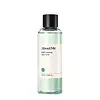What's inside
What's inside
 Key Ingredients
Key Ingredients

 Benefits
Benefits

 Concerns
Concerns

 Ingredients Side-by-side
Ingredients Side-by-side

Chamaecyparis Obtusa Water
MaskingDipropylene Glycol
Humectant1,2-Hexanediol
Skin ConditioningPropanediol
SolventWater
Skin ConditioningXylitol
HumectantMelia Azadirachta Leaf Extract
Skin ConditioningAlthaea Rosea Flower Extract
Skin ConditioningSalvia Officinalis Oil
MaskingMelia Azadirachta Flower Extract
Skin ConditioningArtemisia Vulgaris Oil
PerfumingOcimum Basilicum Oil
MaskingBorago Officinalis Extract
EmollientCentaurea Cyanus Flower Extract
AstringentCentella Asiatica Leaf Extract
Skin ConditioningChamomilla Recutita Flower/Leaf Extract
AntimicrobialHyacinthus Orientalis Extract
Skin ConditioningLavandula Angustifolia Flower Water
Skin ConditioningSalvia Sclarea Extract
AntiseborrhoeicMelaleuca Alternifolia Leaf Extract
PerfumingGlycereth-26
HumectantOctyldodeceth-16
EmulsifyingButylene Glycol
HumectantEthylhexylglycerin
Skin ConditioningMandelic Acid
AntimicrobialAllantoin
Skin ConditioningSodium Citrate
BufferingSodium Phytate
Pentylene Glycol
Skin ConditioningBeta-Glucan
Skin ConditioningCaprylyl Glycol
EmollientXanthan Gum
EmulsifyingChamaecyparis Obtusa Water, Dipropylene Glycol, 1,2-Hexanediol, Propanediol, Water, Xylitol, Melia Azadirachta Leaf Extract, Althaea Rosea Flower Extract, Salvia Officinalis Oil, Melia Azadirachta Flower Extract, Artemisia Vulgaris Oil, Ocimum Basilicum Oil, Borago Officinalis Extract, Centaurea Cyanus Flower Extract, Centella Asiatica Leaf Extract, Chamomilla Recutita Flower/Leaf Extract, Hyacinthus Orientalis Extract, Lavandula Angustifolia Flower Water, Salvia Sclarea Extract, Melaleuca Alternifolia Leaf Extract, Glycereth-26, Octyldodeceth-16, Butylene Glycol, Ethylhexylglycerin, Mandelic Acid, Allantoin, Sodium Citrate, Sodium Phytate, Pentylene Glycol, Beta-Glucan, Caprylyl Glycol, Xanthan Gum
Melaleuca Alternifolia Leaf Extract
PerfumingDipropylene Glycol
HumectantCentella Asiatica Extract
CleansingButylene Glycol
HumectantMelaleuca Alternifolia Flower/Leaf/Stem Extract
Skin ConditioningBetaine
HumectantPanthenol
Skin ConditioningSodium Citrate
BufferingCitric Acid
BufferingMelaleuca Alternifolia Leaf Oil
AntioxidantBetaine Salicylate
AntimicrobialXanthan Gum
EmulsifyingWater
Skin ConditioningEthylhexylglycerin
Skin ConditioningPentylene Glycol
Skin ConditioningOctyldodeceth-16
EmulsifyingCholeth-24
EmulsifyingMelaleuca Alternifolia Leaf Water
Antimicrobial1,2-Hexanediol
Skin ConditioningTocopherol
AntioxidantMelaleuca Alternifolia Leaf Extract, Dipropylene Glycol, Centella Asiatica Extract, Butylene Glycol, Melaleuca Alternifolia Flower/Leaf/Stem Extract, Betaine, Panthenol, Sodium Citrate, Citric Acid, Melaleuca Alternifolia Leaf Oil, Betaine Salicylate, Xanthan Gum, Water, Ethylhexylglycerin, Pentylene Glycol, Octyldodeceth-16, Choleth-24, Melaleuca Alternifolia Leaf Water, 1,2-Hexanediol, Tocopherol
 Reviews
Reviews

Ingredients Explained
These ingredients are found in both products.
Ingredients higher up in an ingredient list are typically present in a larger amount.
1,2-Hexanediol is a synthetic liquid and another multi-functional powerhouse.
It is a:
- Humectant, drawing moisture into the skin
- Emollient, helping to soften skin
- Solvent, dispersing and stabilizing formulas
- Preservative booster, enhancing the antimicrobial activity of other preservatives
Butylene Glycol (or BG) is used within cosmetic products for a few different reasons:
Overall, Butylene Glycol is a safe and well-rounded ingredient that works well with other ingredients.
Though this ingredient works well with most skin types, some people with sensitive skin may experience a reaction such as allergic rashes, closed comedones, or itchiness.
Learn more about Butylene GlycolDipropylene Glycol is a synthetically created humectant, stabilizer, and solvent.
This ingredient helps:
Dipropylene glycol is technically an alcohol, but it belongs to the glycol family (often considered part of the ‘good’ alcohols). This means it is hydrating and gentle on skin unlike drying solvent alcohols like denatured alcohol.
As a masking agent, Dipropylene Glycol can be used to cover the smell of other ingredients. However, it does not have a scent.
Studies show Dipropylene Glycol is considered safe to use in skincare.
Learn more about Dipropylene GlycolEthylhexylglycerin (we can't pronounce this either) is commonly used as a preservative and skin softener. It is derived from glyceryl.
You might see Ethylhexylglycerin often paired with other preservatives such as phenoxyethanol. Ethylhexylglycerin has been found to increase the effectiveness of these other preservatives.
Melaleuca Alternifolia Leaf Extract comes from the Tea Tree, Melaleuca alternifolia, Myrtaceae. This tea tree is native to Australia.
Tea Leaf extract contains antimicrobial and anti-acne properties.
This ingredient has perfuming properties and contains linalool and limonene. These fragrance and terpinen components can cause skin sensitivity.
Learn more about the benefits of Tea Tree Oil here.
Learn more about Melaleuca Alternifolia Leaf ExtractOctyldodeceth-16 comes from the fatty-alcohol Octyldodecanol.
Emulsifers keep oils and water ingredients together to create a more even consistency.
Pentylene glycol is typically used within a product to thicken it. It also adds a smooth, soft, and moisturizing feel to the product. It is naturally found in plants such as sugar beets.
The hydrophilic trait of Pentylene Glycol makes it a humectant. As a humectant, Pentylene Glycol helps draw moisture from the air to your skin. This can help keep your skin hydrated.
This property also makes Pentylene Glycol a great texture enhancer. It can also help thicken or stabilize a product.
Pentylene Glycol also acts as a mild preservative and helps to keep a product microbe-free.
Some people may experience mild eye and skin irritation from Pentylene Glycol. We always recommend speaking with a professional about using this ingredient in your routine.
Pentylene Glycol has a low molecular weight and is part of the 1,2-glycol family.
Learn more about Pentylene GlycolSodium Citrate is the sodium salts of citric acid. In skincare, it is used to alter pH levels and acts as a preservative.
Its main functions are to maintain the pH of a product and neutralize metal ions.
The acidity of our skin is maintained by our glands and skin biome; normal pH level of skin is slightly acidic (~4.75-5.5).
Being slightly acidic allows our skin to create an "acid mantle". This acid mantle is a thin barrier that protects our skin from bacteria and contaminants.
Learn more about Sodium CitrateWater. It's the most common cosmetic ingredient of all. You'll usually see it at the top of ingredient lists, meaning that it makes up the largest part of the product.
So why is it so popular? Water most often acts as a solvent - this means that it helps dissolve other ingredients into the formulation.
You'll also recognize water as that liquid we all need to stay alive. If you see this, drink a glass of water. Stay hydrated!
Learn more about WaterXanthan gum is used as a stabilizer and thickener within cosmetic products. It helps give products a sticky, thick feeling - preventing them from being too runny.
On the technical side of things, xanthan gum is a polysaccharide - a combination consisting of multiple sugar molecules bonded together.
Xanthan gum is a pretty common and great ingredient. It is a natural, non-toxic, non-irritating ingredient that is also commonly used in food products.
Learn more about Xanthan Gum